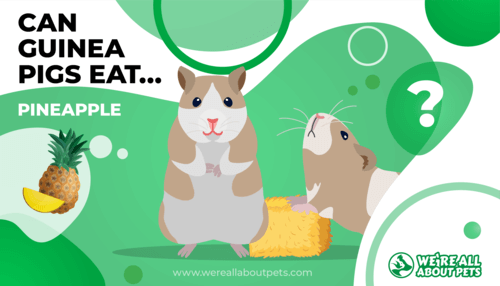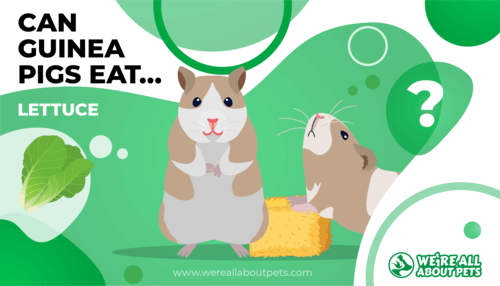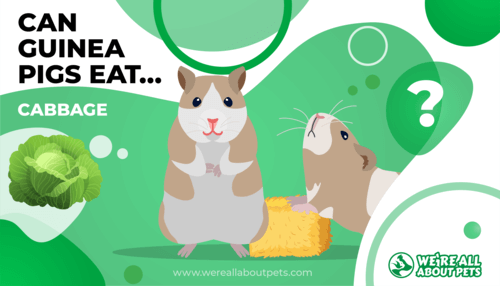Can Guinea Pigs Eat Pears?
This page contains affiliate links. We may earn money or products from the companies mentioned in this post through our independently chosen links, which earn us a commission. Learn More
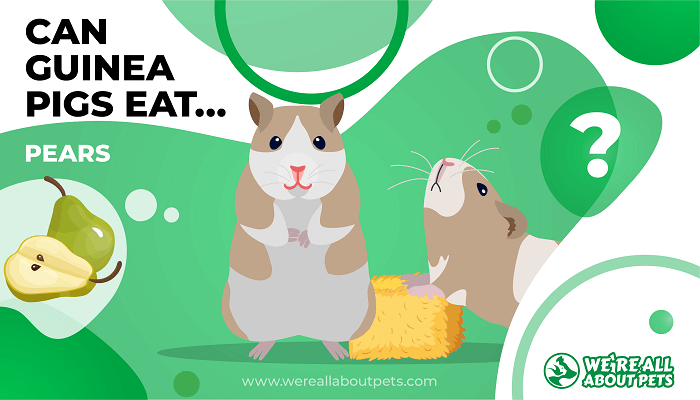
Baked into a crumble, poached, or simply enjoyed raw, pears are a delicious fruit with a unique texture. If you’ve got some fresh pears on hand, you’re probably wondering whether you can offer some to your furry friend.
They’re questions we hear all the time: Can guinea pigs have pears? If so, how much can they eat? And how often can a guinea pig have pear treats?
First things first.
Yes! Guinea pigs can have pears. Even though they aren’t part of a guinea pig’s natural diet, pears can be a healthy treat in moderation.
Ready for more? Read on and soon you’ll be well-informed on the topic of pears for guinea pigs.
Pear Nutrition Stats
If you like pears, you’re in luck, because they’re pretty good for you – and not too bad for your guinea pig!
A medium-sized ripe raw pear gives you approximately:
- 103 calories
- 5 g carbohydrates
- 5 g fiber
- .7 g protein
- .2 g fat
Pears Nutritional Facts
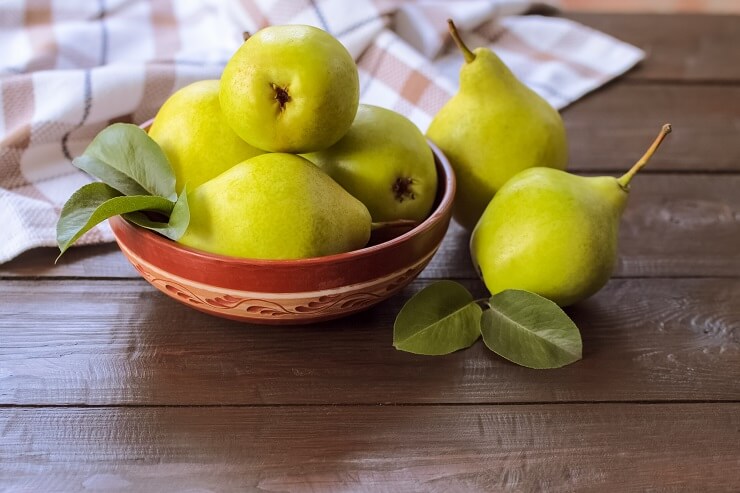
Even though pears aren’t the most colorful fruits around, they’ve got lots of essential nutrients. There’s not a lot of one single thing but all together, you get lots of nutrition in a yummy package with a fun shape.
That same ripe, medium-sized pear offers about:
- 9 iu vitamin A
- 212 mg potassium
- 5 mg vitamin C
- .1 mg manganese
- 5 mg magnesium
- .1 mg pantothenic acid
- .1 mg copper
- .2 mg zinc
- 6 mg phosphorus
- 8 mcg vitamin K
- 5 mcg folate
Can Guinea Pigs Have Pears?
Yes! You can give pears to a guinea pig.
Keep in mind, just like other sweet fruits, guinea pigs can have pears only once in a while, and only in small amounts.
You can’t simply toss a pear into your guinea pig’s cage. Instead, you’ll need to prepare it carefully.Wash the pear well before you give a piece to your guinea pig and be sure to remove the stem and seeds.
Are Pears Good For Guinea Pigs?
Let’s put it this way: Pears are OK for guinea pigs to eat. They’ve got some vitamin C, a bit of vitamin A, and not a whole lot of calcium, all good things from a cavy’s perspective.
The combination of high sugar and water can lead to diarrhea in guinea pigs if overeaten. So you’ll want to offer just the right amount – no more.
Do Guinea Pigs Like Pears?
Yes! Guinea pigs love pears. In fact, we’ve never met a guinea pig that didn’t like pears every now and then.
How Much Pear Can A Guinea Pig Eat?
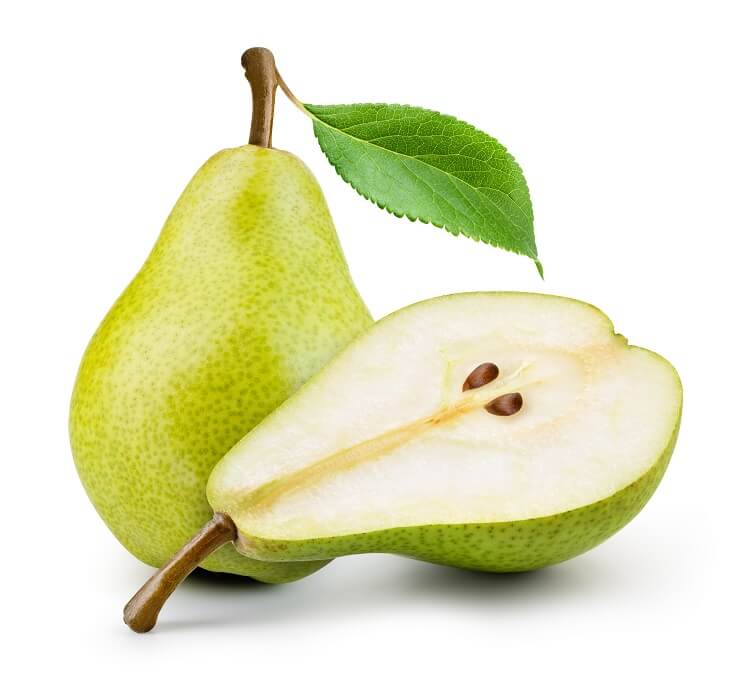
Guinea pigs everywhere are hoping for a feast! It’s not gonna happen, though.
Here’s how much pear to feed your guinea pig:
| Age | Amount |
| Baby guinea pig | None |
| Adult guinea pig | 1 tablespoon (about 1 thin slice) |
Don’t feel sad. Your guinea pig will get lots of enjoyment from that little slice of pear, and it isn’t enough to make them terribly sick.
Since it’s always best to take a careful approach when giving new food to a guinea pig, you’ll want to offer just a tiny taste of pear the first time you give it to your cavy. A quarter of the recommended serving size – what would amount to a very tiny nibble for you – is enough.
After your guinea pig tries their first taste of pear, keep an eye out for any signs that the fruit isn’t a good match for your pet’s digestive system. Diarrhea, bloating, and digestive distress aren’t common with tiny bits of fruit, but anything is possible.
So long as everything is normal, you can gradually increase the amount of pear you give to your cavy. Within a few days, they can enjoy the full serving size!
How Often Can A Guinea Pig Eat Pears?
Even though pears are a nice natural treat for guinea pigs, they’re not something your cavy should eat frequently.
You can give your guinea pig a small slice of pear once a week or once every two weeks, and not on the same days as you offer other sweet treats. Too many sweets can harm your pet!
The Correct Diet Is Important
If a wild guinea pig were to come upon a pear, they’d probably eat it with reckless abandon and then they’d have the tummy ache of a lifetime. Luckily, this isn’t a likely scenario! Since pears aren’t part of your guinea pig’s natural diet, what should you feed them instead?
Here’s a quick guide to feeding your guinea pig the right way.
- Offer an unlimited supply of hay to replace the grasses and vegetation that make up a guinea pig’s natural diet. Guinea pigs eat different kinds of hay including oat, orchard, and timothy.
- Feed your pet a serving of balanced guinea pig food every day. The package will tell you how much to feed your cavy based on life stage and size.
- Give your guinea pig about one cup of fresh vegetables each day, divided into two to three smaller meals. Rotate the kinds of leafy greens and crunchy veggies you offer throughout the week. This helps prevent oxalic acid buildup and reduces your cavy’s risk of kidney stones.
- Offer an unlimited amount of clean, fresh water. Rinse and refill your guinea pig’s drinking bottle every day.
What Are Other Healthy Alternatives To Pears In A Guinea Pig’s Diet?
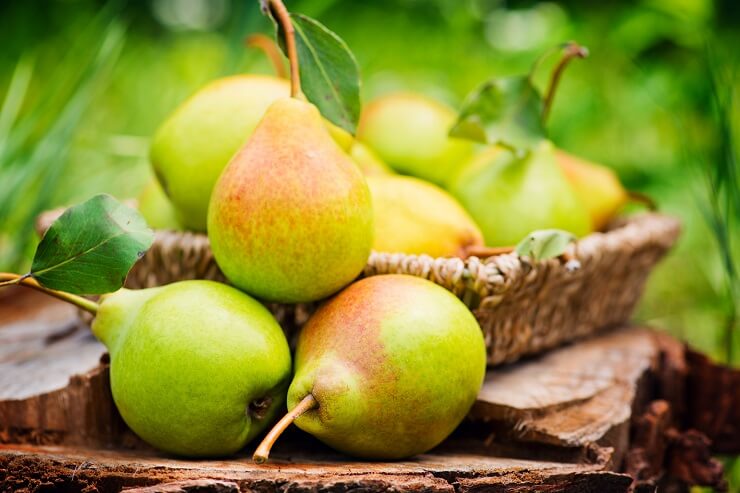
Guinea pigs can only have a certain amount of pears. The good news is there are lots of other healthy, natural treats your can give your cavy.
Try:
- green beans
- escarole
- rocket
- spinach
- carrot
- carrot tops
- romaine
- cabbage
- buttercrunch lettuce
- cucumber
- zucchini
- summer squash
- pumpkin
- winter squash
- artichoke
- parsley
- basil
- beets
- beet tops
- cilantro
- mint
- arugula
- swiss chard
- sweet potato
- butter lettuce
- bibb lettuce
- bell pepper
- endive
- parsnip
- tomato
- bok choy
- asparagus
- yu choy
- broccolini
- broccoli
- brussels sprouts
- watercress
This list might look pretty long – and there are lots of interesting foods on it – but the truth is, it’s just the beginning. There are many other foods that guinea pigs can eat, and many of them are probably on your own menu!
Since some foods aren’t safe for guinea pigs, it’s important to spend a few minutes learning about each new item you consider adding to your cavy’s menu. This way, you’ll ensure your pet’s safety plus you’ll learn how much of each food your guinea pig ought to have.
Now though, it’s time for some fun! Giving your guinea pig pears is a great way to brighten up their day and give them a little bit of extra nutrition. Nibble away!
Frequently Asked Questions
Are pears safe for guinea pigs?
Yes, so long as you give them the recommended amount and no more.
Can pears make my guinea pig sick?
Yes. We don’t like to be the bearers of bad news but sweet foods including pears can cause diarrhea in guinea pigs. Feeding your cavy too much pear too often can increase the chances of uncomfortable conditions including obesity and diabetes. Not only are these health problems unpleasant, they shorten your guinea pig’s life span.
Can guinea pigs eat pear seeds?
No. Pear seeds are sharp, and they can become lodged in your guinea pig’s throat. Additionally, pear seeds contain traces of cyanide. It’s not enough to seriously harm your pet but truly, they’re not worth the risk. We don’t think guinea pigs like pear seeds, anyway!
Can guinea pigs eat Asian pear?
Absolutely! You can give a cavy Asian pear. Offer the same amount as standard Bartlett, red, or green pears, and remember to introduce this fruit gradually.
Can guinea pigs eat dried pear?
Dried pear is very sticky and sweet – not a good choice for your guinea pig. Only offer fresh pear.
Can guinea pigs have canned pears?
No. Canned pears are full of sugar, plus they’ve been cooked. These two factors mean your guinea pig can’t digest canned pears. Only give your cavy fresh pear.






